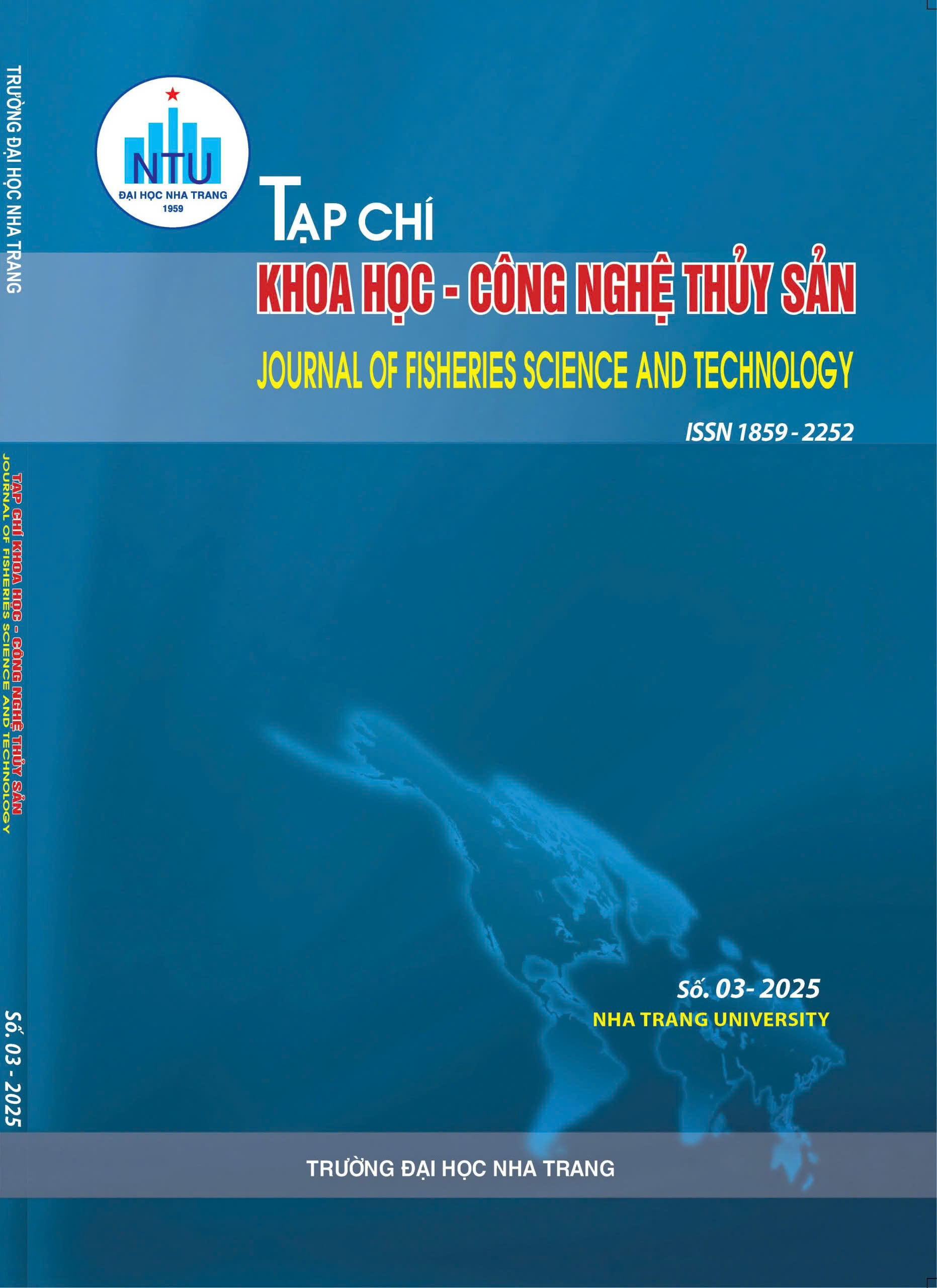##plugins.themes.huaf_theme.article.main##
Tóm tắt
Nghiên cứu được thực hiện nhằm đánh giá mức độ ảnh hưởng của một số loại thức ăn ban đầu, hàm lượng DHA bổ sung khác nhau cho luân trùng (Brachionus plicatilis) đến sinh trưởng và tỷ lệ sống của ấu trùng cá bè vẫu (Caranx ignobilis, Forsskål, 1775). Thời gian thí nghiệm từ khi ấu trùng cá bè vẫu bắt đầu ăn ngoài cho đến khi chuyển sang ăn Artemia thì thí nghiệm kết thúc. Trong thí nghiệm 1(TN1), ấu trùng 3 ngày tuổi được cho ăn ba loại thức ăn: trứng hàu thụ tinh, luân trùng và luân trùng + trứng hàu thụ tinh. Thí nghiệm 2 (TN2) được tiến hành với 5 nghiệm thức làm giàu khác nhau và 1 nghiệm thức đối chứng bao gồm: 70 mg/L, 150 mg/L, 225 mg/L, 300 mg/L, 375 mg/L và 0 mg/L (đối chứng). Mỗi nghiệm thức được lặp lại 3 lần. Kết quả nghiên cứu ở thí nghiệm 1: ấu trùng cho ăn luân trùng có tăng trưởng theo chiều dài nhanh hơn so với ấu trùng cho ăn trứng hàu và trứng hàu + luân trùng, trong khi ấu trùng ăn trứng hàu có tỷ lệ sống thấp hơn so với các nghiệm thức khác. Kết quả nghiên cứu ở thí nghiệm 2 cho thấy việc bổ sung DHA làm giàu đều ảnh hưởng đến tốc độ tăng trưởng, tỷ lệ sống và sinh khối của ấu trùng cá bè vẫu (P<0,05), trong đó hàm lượng bổ sung 300mg/L được xác định là tối ưu. Khi mức bổ sung tăng lên 375mg/L không những không cải thiện tỷ lệ sống mà còn làm giảm kết quả ương, tương đương với nghiệm thức đối chứng 0 mg/L. Từ nghiên cứu này có thể kết luận ấu trùng cá bè vẫu nên được cho ăn luân trùng làm giàu ở mức 300mg/L ở giai đoạn bắt đầu ăn ngoài nhằm đạt được tốc độ tăng trưởng, tỷ lệ sống và sinh khối tối ưu.
Từ khóa: Cá bè vẫu, làm giàu luân trùng, trứng hàu, ấu trùng, thức ăn sống
ABSTRACT
This study was conducted to evaluate the effects of different types of initial feed and various levels of DHA supplementation for rotifers (Brachionus plicatilis) on the growth, survival rate of giant trevally (Caranx ignobilis, Forsskål 1775) larvae. The experimental period lasted from the onset of exogenous feeding until the larvae transitioned to Artemia, at which point the experiment ended. In Experiment 1, three-day-old larvae were fed with three different diets: fertilized oyster eggs, rotifers, and a combination of rotifers and fertilized oyster eggs. Experiment 2 was carried out using five different DHA enrichment levels for rotifers and one control treatment: 70 mg/L, 150 mg/L, 225 mg/L, 300 mg/L, and 375 mg/L and 0 mg/L (control treatment), with each treatment replicated three times. The results showed that in Experiment 1, larvae fed with rotifers exhibited greater length growth compared to those fed oyster eggs or the combination of oyster eggs and rotifers. Larvae fed with oyster eggs alone had the lowest survival rate among the treatments. The results of Experiment 2 showed that DHA enrichment supplementation significantly affected the growth rate, survival rate, and biomass of giant trevally larvae (P<0.05), with the 300 mg/L enrichment level identified as optimal. Increasing the supplementation level to 375 mg/L did not improve survival and even led to reduced rearing performance, comparable to the control treatment (0 mg/L). Based on this study, it can be concluded that giant trevally larvae should be fed DHA-enriched rotifers at a level of 300 mg/L during the initial exogenous feeding stage to achieve optimal growth rate, survival, and biomass
Keywords: Giant trevally, rotifer enrichment, fertilized oyster eggs, larvae, live foods.

